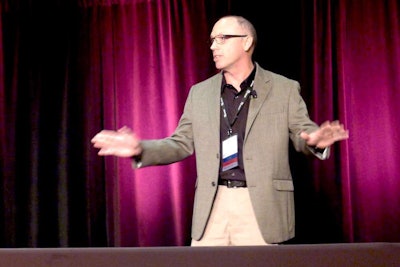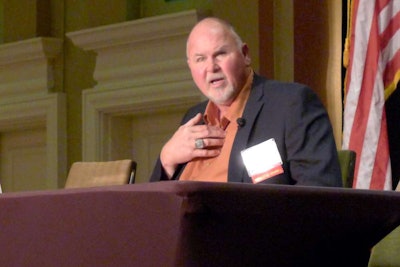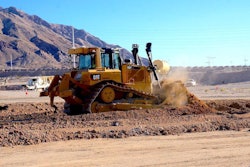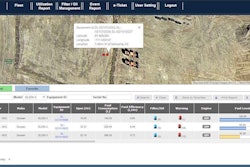 Guy Gordon, CEM, director of asset management at Aegion, speaks at the 2014 AEMP Asset Management Symposium in Nashville.
Guy Gordon, CEM, director of asset management at Aegion, speaks at the 2014 AEMP Asset Management Symposium in Nashville.There will come a time in every construction company’s life, when a trigger event will make the deployment of telematics not only advisable, but even necessary. And that time is fast approaching for almost every company, said Guy Gordon, CEM, director of asset management at Aegion, and Dan Samford, vice president equipment assets, Herzog Contracting.
Gordon and Samford headed up the panel discussion “Using Telematics Data to Achieve Competitive Advantage” at last week’s Association of Equipment Management Professionals 2014 Asset Management Symposium in Nashville, Tennessee. The two veteran fleet managers both began using telematics in 2004, and also shared with some 300 attendees at the symposium a number of anecdotes and tips about how to make sense of and profit from telematics.
Facing fines and losses
For Gordon’s firm, the trigger event was a potential fine from a regulatory agency. “The decision was made to invest in technology to merge our electronic fuel purchases with telematics data to get the trip reports put together,” said Gordon. The telematics data verified that Aegion was adhering to the law and a significant fine was avoided.
At Herzog, Samford was struggling with a change order that, because the way the project was bid, was going to cause costs to skyrocket. By having the telematics data prove the real cost of the change order, Herzog avoided the loss of several million dollars.
“Beyond that it has grown exponentially,” Samford said. “We have reduced our owning and operating costs dramatically and reduced the number of machines required to do the same amount of work.”
Sharing the information
Some contractors in the past have hesitated to use telematics over concerns about who gets to see their telematics data. Gordon and Samford said that mindset is all wrong.
 Dan Samford, vice president of equipment assets for Herzog Contracting.
Dan Samford, vice president of equipment assets for Herzog Contracting.Samford shares his telematics data with his fuel supplier. The drivers of the fuel trucks can see which machines need fuel and which ones didn’t work that day. Often enough, that saves the fuel truck drivers from going five or 10 miles out of their way needlessly. But Samford doesn’t do this out of the goodness of his heart. He uses this information sharing to get a better price on his fuel contracts.
Herzog also gives its banking and insurance providers access to the data, said Samford. “That transparency extends our credibility. There is more than one stakeholder in this, more than one department, one division,” he said.
Likewise with equipment dealers. “If my distributors are not watching our telematics, they will soon no longer be my distributor,” Samford said. “If they don’t want to do it, we’ll find someone who will. I want that phone call where the guy says, ‘There is a problem with one of your machines and we are on it.'”
Every company is different
With a decade of telematics experience each, Gordon and Samford agree that it takes a lot of work and thinking to understand how to use the technology effectively. “You need to decide what’s important to your business to create a competitive advantage,” Gordon said, noting that how he uses telematics is very different from how Samford uses it.
“If you are looking at telematics for just the equipment department, you’re looking at it for the wrong reasons,” Gordon said. “Telematics should be something your whole organization uses. You need to decide how this can make you competitive and then you need to drive it to the people that can help you be competitive. The shop manager is part of that, also the CEO and the CFO, operations, human resources and safety.”
Planning comes first
Another challenge contractors discover when looking at telematics data is that it is like trying to drink water from a firehose. The amount of information is overwhelming, more than anyone could possibly use.
The solution, said Gordon and Samford, is to start by identifying what it is you want to achieve before you purchase a system. What kinds of information do you want, who will need or use the information and how will the information be presented? Answering these questions is your first step.
“Like most information systems, only a small portion of the functionality will be used,” Gordon said. “What drives your business? What is important to you that telematics provides?” The rest you can ignore, even turn off, until you get more familiar with a system and start looking for additional benefits.
“The ROI is there,” said Samford. “You just have to look for it. If you are going to put your head in the sand, if you say it costs too much, you’re looking at the wrong things. You can use it in so many ways if you just commit to it. As you use it you will find more ways and more features that are beneficial to your particular application.”
Finding a champion
Another key to successful telematics adoption is to put in place a person who can serve as a champion of the technology and help everybody connect to the information they need.
In the case of Aegion, a position was created for a person who would specifically learn its telematics system better than anybody else, said Gordon. “So when somebody needs something out of this system, whether it’s operations, HR or the CFO, they can go to this person and ask for it. That person is responsible for figuring out a way to do it,” he said.
Herzog also has an identified point person. “For his first four months we put that guy to work installing black boxes from Florida to California,” said Samford. “After he got good at that, we had him train our vendors to do installations the way we wanted them.” One reason Herzog thought installations were a crucial part of the training process is that when there is a problem with a unit, it can usually be traced back to a faulty installation.












